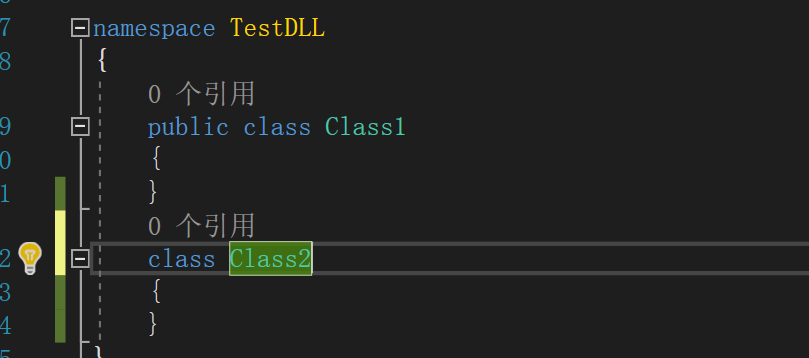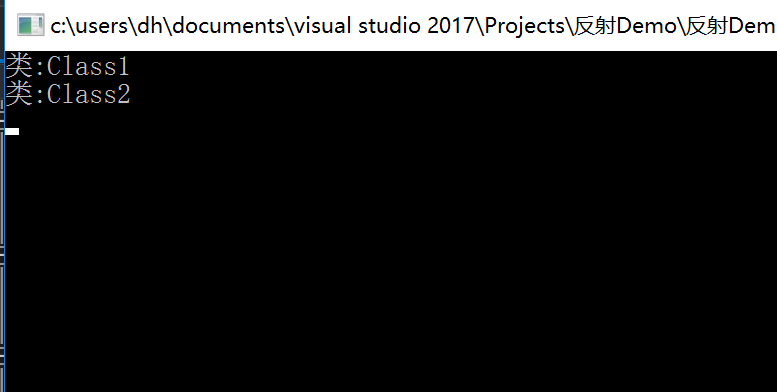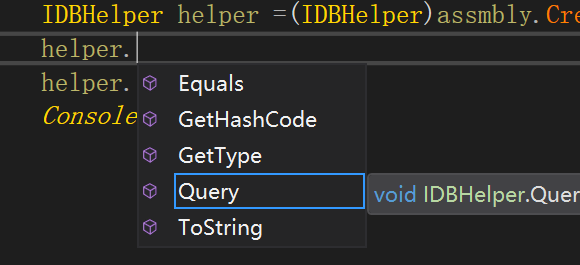6.C#知识点:反射
1.反射是什么?
反射提供描述组件,模块和类型的对象(类型为Type)。您可以使用反射来动态创建类型的实例,将类型绑定到现有对象,或从现有对象获取类型,并调用其方法或访问其字段和属性。如果您在代码中使用属性,反射使您可以访问它们。有关更多信息,请参阅属性。-----来自微软官方。
微软的解释我觉得还可以。用大白话讲就是我们可以以通过反射让我们知道未知类型的信息。类似现实生活中的B超啊。医生用B超看到孕妇肚子里的内部情况,因为医生无法从内部查看。反射也是一样,对于未知类型。或者引用过来的dll。我们是不知道内部情况的。但是可以通过反射。蝙蝠的超声波也是。通过声波反射回来,得知前方是否有障碍。这就是反射的功能。如果要问反射内部是如何实现的。不好意思。目前我也不知道。哈哈哈哈。
简单的来说,我们的程序是由dll的组成的,dll里面有许许多多的类组成。类里面又有字段,属性和方法。反射的作用就是给个dll就能知道有哪些类,通过类又能知道有哪些成员。那么.net里面的反射是怎么做到呢?那下面就要介绍几个种类的反射类了。
(1)使用Assembly定义和加载程序集,加载在程序集清单中列出模块,以及从此程序集中查找类型并创建该类型的实例。
(2)使用Module了解包含模块的程序集以及模块中的类等,还可以获取在模块上定义的所有全局方法或其他特定的非全局方法。
(3)使用ConstructorInfo了解构造函数的名称、参数、访问修饰符(如pulic 或private)和实现详细信息(如abstract或virtual)等。
(4)使用MethodInfo了解方法的名称、返回类型、参数、访问修饰符(如pulic 或private)和实现详细信息(如abstract或virtual)等。
(5)使用FiedInfo了解字段的名称、访问修饰符(如public或private)和实现详细信息(如static)等,并获取或设置字段值。
(6)使用EventInfo了解事件的名称、事件处理程序数据类型、自定义属性、声明类型和反射类型等,添加或移除事件处理程序。
(7)使用PropertyInfo了解属性的名称、数据类型、声明类型、反射类型和只读或可写状态等,获取或设置属性值。
(8)使用ParameterInfo了解参数的名称、数据类型、是输入参数还是输出参数,以及参数在方法签名中的位置等。这段话是从大牛的博客拷贝------->传送门
下面我依次重点的介绍几个详细的类。
首先是Assembly。这个存在于System.Reflection命名空间下面。我主要讲它的3个加载程序集的的方法和区别。Load,LoadForm,LoadFile。
讲了这么多文字,先从代码看看语法。
using System; using System.Collections.Generic; using System.Linq; using System.Reflection; using System.Text; using System.Threading.Tasks; namespace 反射Demo { class Program { static void Main(string[] args) { //加载程序集 Assembly assembly = Assembly.Load("TestDLL"); //输出程序集的强名称 Console.WriteLine(assembly.FullName); Console.ReadKey(); } } }

Load方法就是通过程序集的的名称加载程序,但是需要要加载的程序集在当前程序集的bin目录下才能找得到。
LoadForm
using System; using System.Collections.Generic; using System.Linq; using System.Reflection; using System.Text; using System.Threading.Tasks; namespace 反射Demo { class Program { static void Main(string[] args) { #region Load方法 //加载程序集 // Assembly assembly = Assembly.Load("TestDLL"); //输出程序集的强名称 //Console.WriteLine(assembly.FullName); //Console.ReadKey(); #endregion Assembly assmbly1 = Assembly.LoadFrom(@"C:\Users\DH\Documents\visual studio 2017\Projects\反射Demo\TestDLL\bin\Debug\TestDLL.dll"); Console.WriteLine(assmbly1.FullName); Console.ReadKey(); } } }
LoadForm是通过路径进行创建。返回加载的程序集。
来看最后一个loadFile
using System; using System.Collections.Generic; using System.Linq; using System.Reflection; using System.Text; using System.Threading.Tasks; namespace 反射Demo { class Program { static void Main(string[] args) { #region Load方法 //加载程序集 // Assembly assembly = Assembly.Load("TestDLL"); //输出程序集的强名称 //Console.WriteLine(assembly.FullName); //Console.ReadKey(); #endregion #region LoadFrom方法 //Assembly assmbly1 = Assembly.LoadFrom(@"C:\Users\DH\Documents\visual studio 2017\Projects\反射Demo\TestDLL\bin\Debug\TestDLL.dll"); //Console.WriteLine(assmbly1.FullName); ///Console.ReadKey(); #endregion #region LoadFile方法 Assembly assmbly2 = Assembly.LoadFile(@"C:\Users\DH\Documents\visual studio 2017\Projects\反射Demo\TestDLL\bin\Debug\TestDLL.dll"); Console.WriteLine(assmbly2.FullName); Console.ReadKey(); #endregion } } }
这个三个方法语法都很简单。现在来说说这个三个的区别,和优缺点。
LoadFrom和Load:LoadForm同一个程序集只加载一次,就算加载了不通的路径相同的程序集,他也只能给你返回之前的程序集,LoadFrom只能用于加载不同标识的程序集, 也就是唯一的程序集, 不能用于加载标识相同但路径不同的程序集。
LoadFile和LoadForm:loadFile只会加载本身程序集,不会加在其引用的程序集,LoadForm和Load是会加载的其引用程序集。而且LoadFile同一个程序集只能加载一次。这个和LoadForm是一样。
从性能上看 LoadForm没有Load好,功能上也是load强一点。应用的时候如果loadFom和load都满足需求,建议用load。
这几个方法还几个重载版本。由于本片只是基础篇。篇幅不宜过多。想深入了解的小伙伴可以查询MSN看看文档。最详细的说明就是文档。但是文档说的比较官方。结合大牛们写的博客。更容易懂一点。
好了我们开始下一个阶段了。程序集现在我们得了。我开始看看程序集里面有些啥?

using System; using System.Collections.Generic; using System.Linq; using System.Reflection; using System.Text; using System.Threading.Tasks; namespace 反射Demo { class Program { static void Main(string[] args) { #region LoadFrom方法 Assembly assmbly = Assembly.LoadFrom(@"C:\Users\DH\Documents\visual studio 2017\Projects\反射Demo\TestDLL\bin\Debug\TestDLL.dll"); Type[] types = assmbly.GetTypes(); foreach (var item in types) { Console.WriteLine("类:"+item.Name); } Console.ReadKey(); #endregion } } }

assmbly.GetTypes()这个方法或获取了所有类。
下面我我展示下获取字段和方法的字段
using System; using System.Collections.Generic; using System.Linq; using System.Reflection; using System.Text; using System.Threading.Tasks; namespace 反射Demo { class Program { static void Main(string[] args) { #region LoadFrom方法 Assembly assmbly = Assembly.LoadFrom(@"C:\Users\DH\Documents\visual studio 2017\Projects\反射Demo\TestDLL\bin\Debug\TestDLL.dll"); Type[] types = assmbly.GetTypes(); foreach (var classitem in types) { Console.WriteLine("类:"+ classitem.Name); foreach (var fileditem in classitem.GetFields()) { Console.WriteLine("字段名:"+ fileditem.Name); } foreach (var methodItem in classitem.GetMethods()) { Console.WriteLine("方法名:"+methodItem.Name); } } Console.ReadKey(); #endregion } } }

可以看的出来我们将字段和方法名都给反射出来了,但是有个问题就是我们父类的方法也给弄出来了。我们可以修改下。这个地方有个重载版本。GetMethods有个重载方法可以通过BindingFlags枚举参数进行筛选父类的方法,或者其他的。 BindingFlags这个枚举类型。这里就不多讲。未来我会慢慢补全。
简单的就是这么多了。反射能做好多事情,非常灵活。我们抽象工厂里面就会用到反射。我们的工厂。就是通过反射创建出来。下面我写个demo演示下其作用。
using System; using System.Collections.Generic; using System.Linq; using System.Reflection; using System.Text; using System.Threading.Tasks; using TestDLL; namespace 反射Demo { class Program { static void Main(string[] args) { Assembly assmbly = Assembly.Load("TestDLL"); SqlServerHelper helper =(SqlServerHelper)assmbly.CreateInstance("TestDLL.SqlServerHelper"); helper.Query(); Console.ReadKey(); } } }
小伙伴们可以发现。我们实例化了一个SqlServerHelper对象,但是我们没有用正常的new方法,而是用了反射。这个时候有的小伙伴可能就会说这是脱裤子放屁,直接new多简单。在这里是没错,但是放在真正的项目里直接new是当时爽,需求变动就等着哭吧,比如说以后领导对你说,公司的数据库不用SqlServer了,换成Oracle了。这是时候如果你是new的话还要改这里的代码,实际情况可能更复杂。但是用了我们的反射,这种烦恼就不会存在了。
CreateInstance("TestDLL.SqlServerHelper") 这个方法参数我们完全可以通过配置文件修改。这个类就不需要变了。我来演示下代码
using System; using System.Collections.Generic; using System.Linq; using System.Text; using System.Threading.Tasks; namespace TestDLL { public interface IDBHelper { void Query(); } }
先创建一个约定数据操作的接口 IDBHlper类。规定有一个Query方法,然后让SqlServerHelper继承这个接口,并且实现这个方法。
using System; using System.Collections.Generic; using System.Linq; using System.Text; using System.Threading.Tasks; namespace TestDLL { public class SqlServerHelper: IDBHelper { public void Query() { Console.WriteLine("这是测试"); } } }
然后修改mian函数的方法
<?xml version="1.0" encoding="utf-8" ?> <configuration> <startup> <supportedRuntime version="v4.0" sku=".NETFramework,Version=v4.5" /> </startup> <appSettings> <add key="Helper" value="TestDLL.SqlServerHelper"/> </appSettings> </configuration>
using System; using System.Collections.Generic; using System.Configuration; using System.Linq; using System.Reflection; using System.Text; using System.Threading.Tasks; using TestDLL; namespace 反射Demo { class Program { static void Main(string[] args) { Assembly assmbly = Assembly.Load("TestDLL"); string helperkey = ConfigurationManager.AppSettings["Helper"]; IDBHelper helper =(IDBHelper)assmbly.CreateInstance(helperkey); helper.Query(); Console.ReadKey(); } } }
这时候如果要将mian函数里面helper切换成Oracle的只要添加一个继承于IDBheper接口的类,然后实现方法,在修改配置文件指向这个类,然后就可以了。对于main函数我们是一点不需要动的,这是就是我们所有的高内聚低耦合。完成解耦。易于修改。
using System; using System.Collections.Generic; using System.Linq; using System.Text; using System.Threading.Tasks; namespace TestDLL { public class OracleHelper : IDBHelper { public void Query() { Console.WriteLine("我是Orcle数据库"); } } }
<?xml version="1.0" encoding="utf-8" ?> <configuration> <startup> <supportedRuntime version="v4.0" sku=".NETFramework,Version=v4.5" /> </startup> <appSettings> <add key="Helper" value="TestDLL.OracleHelper"/> </appSettings> </configuration>
using System; using System.Collections.Generic; using System.Configuration; using System.Linq; using System.Reflection; using System.Text; using System.Threading.Tasks; using TestDLL; namespace 反射Demo { class Program { static void Main(string[] args) { Assembly assmbly = Assembly.Load("TestDLL"); string helperkey = ConfigurationManager.AppSettings["Helper"]; IDBHelper helper =(IDBHelper)assmbly.CreateInstance(helperkey); helper.Query(); Console.ReadKey(); } } }
mian函数一点都没有变化。运行查看结果

到了这个里,我已经演示了一个反射应用场景了。其实VS本身就很多地方用了反射。比如。创建对象调用方法时候 VS直接只能帮我们列出这个对象下的成员。这个就是通过反射。其实还有很多。等待大家去发现。反射应该属于C#里面的高级知识点了。目前所说的只是冰山一角。
VS直接只能帮我们列出这个对象下的成员。这个就是通过反射。其实还有很多。等待大家去发现。反射应该属于C#里面的高级知识点了。目前所说的只是冰山一角。
Ok。讲到这里就结束了哈。
如果刚开始学习的小伙伴还有疑问的话,可以评论咱们一起学习。
如果哪位大牛随便瞄到个错误,也请告之我,让我能够进步。


